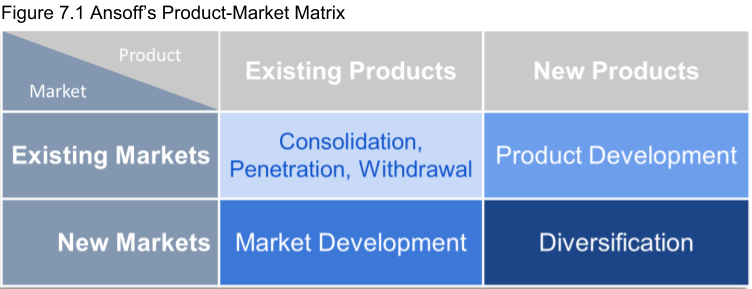Concentration Strategies

For many firms, concentration strategies are very sensible. These strategies involve trying to compete successfully only within a single, broad industry. There are three concentration strategies: (1) market penetration, (2) market development, and (3) product development. A firm can use one, two, or all three as part of their efforts to excel within an industry.[1] Ansoff described these strategies in a matrix, see Figure 7.1. Ansoff’s matrix is a tool for understanding at a high-level, the general direction of growth. It helps a firm match products and markets. The firm must decide whether to prioritize increasing profit or growth and how the firm will achieve it. No one strategy is appropriate for all companies at all times! Markets are defined as customer groups, and products are items sold to customers.
Example 7.1 Market Penetration
Advance Micro Devices (AMD) has steadily increased its market penetration year over year after it began shipping its Ryzen CPUs taking market share from its rival Intel. On average they are currently taking around 5% of market share per year from Intel due to a superior product. The Ryzen CPUs are outselling Intel’s offerings due to an industry best performance per dollar, which is important in the home PC market as well as server markets. AMD is beginning to chip away at Intel’s market share because its offerings are cheaper, better performing, and more innovative resulting in an improvement of market penetration.
Source: Extreme Tech, AMD Gains Market Share in Desktop and Laptop, Slips in Servers, Christopher Burke, 2019Sp
Market Penetration
Market penetration involves increasing the firm’s share within existing markets using existing products. Often firms will rely on advertising to attract new customers within existing markets using loyalty program, coupons, and sales promotions. Nike, for example, features famous athletes in print and television ads designed to take market share within the athletic shoes business from Adidas and other rivals.
Market Development
Example 7.2 Market Development
This article discusses the importance of stock and how it differentiates a company based on how high or low their stock evaluation is. Companies that defy the social norm, such as Amazon and Netflix have a high stock and are growing at an annual rate of 99 and 93 percent, respectively.
Source: Investor’s Business Daily, Who Joins Canada Goose, Square On This List Of Today’s Fastest-Growing Companies?, Carolyn Hoard, 2018Fa
Market development involves selling existing products within new markets. One way to reach a new market is to enter a new retail channel. Starbucks has stepped beyond selling only coffee beans in its stores and now sells beans in grocery stores. This enables Starbucks to reach consumers that do not visit its coffee houses. Entering new geographic areas and adding new sales or distribution channels are other ways to pursue market development.
Product Development
Example 7.3 Product Development
Big brand name companies such as Coke, Pepsi, and Nestle are expanding their product market to add flavored sparkling water. In doing this, they are making a new product that serves an existing market. These new products are aimed to compete with others on the market such as La Croix. A specific example is Pepsico’s new line called Bubly, which already has over $61 million in sales according to market research group IRI.
Source: Bevnet, Big Guys Pursue the Bubbles: Coco-Cola, PepsiCo and Nestle Take Aim at La Croix, 2018Fa
Product development involves creating new products to serve existing markets. In the 1940s, for example, Disney expanded its offerings within the film business by going beyond cartoons and creating movies featuring real actors. More recently, McDonald’s has gradually moved more and more of its menu toward healthy items to appeal beyond its existing base and to attract customers who are concerned about nutrition.
In 2009, Starbucks introduced VIA, an instant coffee variety that executives hoped would appeal to their customers when they do not have easy access to a Starbucks store or a coffee pot. The soft drink industry is a frequent location of product development efforts. Coca-Cola and Pepsi regularly introduce new varieties—such as Coke Zero and Pepsi Cherry Vanilla—in an attempt to take market share from each other and from their smaller rivals.
- Ansoff, H. I. 1957. Strategies for diversification. Harvard Business Review, 35(5), 113–124. ↵

